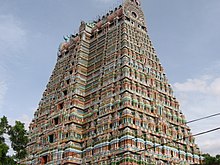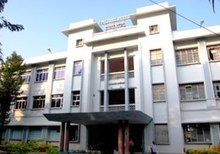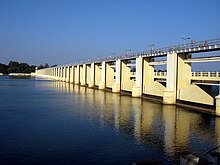Tiruchirappalli district
Tiruchirappalli District is one of the 38 districts, located along the Kaveri River, in Tamil Nadu, India. The headquarters of the district is the city of Tiruchirappalli, also known as Trichy.
During the British Raj, Tiruchirappalli was known as Trichinopoly, and was a district of the Madras Presidency; it was renamed upon India's declaration of independence in 1947. As of 2011, the district had a population of 2,722,290.
Geography[]

Tiruchirappalli district lies almost at the exact centre of Tamil Nadu. The district has an area of 4,404 square kilometers. It is bounded in the north by Salem district, northwest by Namakkal district, in the northeast by Perambalur district, in the east by Ariyalur District and Thanjavur district in the southeast by Pudukkottai district and Sivagangai district in the south by Madurai district, in the southwest by Dindigul district and, in the west by Karur district. The Kaveri river flows through the length of the district and is the principal source of irrigation and drinking water.[citation needed]
Kolli Hills form the boundary of Tiruchirapalli and Namakkal districts and Pachamalai hills form the Boundary of Salem and Perambalur district with Tiruchirapalli district in the North and North East.
The North most and South most parts of the district are hilly, middle part of the district is Kaveri plains. Trichy district is little bit greenary than other surrounding districts due to river Kaveri flowing through this district, by splitting the district into North and South.
Banana Cultivation and Coconut grove along side the Kaveri river in this district gives a pleasant feeling like Kerala.
Demographics[]
According to 2011 census, Tiruchirappalli district had a population of 2,722,290 with a sex-ratio of 1,013 females for every 1,000 males, much above the national average of 929.[4] A total of 272,456 were under the age of six, constituting 139,946 males and 132,510 females. Scheduled Castes and Scheduled Tribes accounted for 17.14% and 0.67% of the population respectively. The average literacy of the district was 74.9%, compared to the national average of 72.99%.[4] The district had a total of 698,404 households. There were a total of 1,213,979 workers, comprising 161,657 cultivators, 319,720 main agricultural labourers, 25,174 in house hold industries, 575,778 other workers, 131,650 marginal workers, 9,012 marginal cultivators, 59,062 marginal agricultural labourers, 5,212 marginal workers in household industries and 58,364 other marginal workers.[5]
| Year | Pop. | ±% p.a. |
|---|---|---|
| 1901 | 807,320 | — |
| 1911 | 876,070 | +0.82% |
| 1921 | 912,177 | +0.40% |
| 1931 | 918,342 | +0.07% |
| 1941 | 1,035,927 | +1.21% |
| 1951 | 1,184,158 | +1.35% |
| 1961 | 1,304,039 | +0.97% |
| 1971 | 1,650,768 | +2.39% |
| 1981 | 1,900,566 | +1.42% |
| 1991 | 2,196,473 | +1.46% |
| 2001 | 2,418,366 | +0.97% |
| 2011 | 2,722,290 | +1.19% |
| source:[6] | ||
Taluks[]

In 2013, Tiruchirappalli district went from nine taluks to eleven taluks.[7]
- Thuraiyur taluk
- Manapparai taluk
- Marungapuri taluk
- Srirangam taluk
- Tiruchirappalli West taluk
- Tiruchirappalli East taluk
- Thiruverumbur taluk
- Lalgudi taluk
- Manachanallur taluk
- Musiri taluk
- Thottiyam taluk
Urban centres[]

Tiruchirappalli District consists of the following urban centres:
- Trichy City

- Thuraiyur town
- Manapparai town
- Thuvakudi town
- Lalgudi town panchayat
- Manachanallur town panchayat
- Musiri town panchayat
- Thottiyam town panchayat
- Uppiliapuram Town panchayat
- Navalurkuttapattu panchayat
- Mettupalayam panchayat
- panchayat
- Balakrishnampatti panchayat
- panchayat
- mangalam panchayat
Major industries[]
- Bharat Heavy Electricals Limited (BHEL)
- High Energy Projectile Factory (HEPF)
- Golden Rock Railway Workshop
- Ordnance Factory Tiruchirappalli
- Light and heavy engineering
- Leather Tanneries
- Food Processing
- Sugar Mills
- (Traditional) Cigar Making (village) Industries
- Hosiery and garments (to a small extent)
- IT/BPO
- Manufacturing of Synthetic Stones for Jewelry
Natural resources and water bodies[]

The major rivers are the River Kaveri and the River Kollidam. The important rivers across city is Koraiyar, Uyyakondan and Kudamuruti rivers.
Agriculture[]
The district has a large cattle and poultry population with agriculture workers in the smaller villages like Kalpalayathanpatti.
The rivers Kaveri and Kollidam start branching out to form the Kaveri delta irrigating vast tracts of land in the district. The major crops are rice (vast tracts); sugarcane (vast tracts); banana/plantain; coconut; cotton (small tracts); betel; corn; and groundnut.
Trichirapalli district is well known for all varieties of Banana Cultivation. Banana research centre is located in Tiruchirapalli Agricultural University.
Hill Jackfruit, Cassava, mountain crops are grown in the Pachamalai hills of Trichirapalli district.
Tourism[]
Notable places to visit in Tiruchirappalli District include:
- Chokkanatha Nayak Palace
- Erumbeeswarar Temple
- Gandhi Market
- Ponmalai (Golden Rock)
- Government Museum, Tiruchirappalli
- Thiruvanai koil Shiva temple
- Kallanai Dam
- Kaveri Palam
- Manachanallur
- Mukkombu
- Neelivaneswarar Temple
- Pachaimalai Hills
- Puliancholai
- Pundarikakshan Perumal Temple
- railway Heritage Centre, Tiruchirappalli
- Srirangam Ranganathaswamy Temple
- Samayapuram Mariamman Temple
- Thuraiyur
- Tiruchirappalli Fort
- Tiruchirappalli International Airport
- Trichy Teppakulam
- Tirupattur
- Tropical butterfly conservatory, Trichy
- Vayalur Murugan Temple
- World War I Memorial (Tiruchirappalli)
See also[]
References[]
- ^ https://www.aninews.in/news/national/general-news/tn-polls-eci-orders-transfer-of-trichy-collector-sp20210326085803/
- ^ https://www.tn.gov.in/contact_directory/district_administration/27
- ^ www.tn.gov.in
- ^ Jump up to: a b "Census Info 2011 Final population totals". Office of The Registrar General and Census Commissioner, Ministry of Home Affairs, Government of India. 2013. Retrieved 26 January 2014.
- ^ "Census Info 2011 Final population totals - Tiruchirappalli district". Office of The Registrar General and Census Commissioner, Ministry of Home Affairs, Government of India. 2013. Retrieved 26 January 2014.
- ^ Decadal Variation In Population Since 1901
- ^ "Residents question move to locate Marungapuri taluk office at Kallupatti". The Hindu. 21 June 2013.
External links[]
| Wikimedia Commons has media related to Tiruchirapalli district. |
- Tiruchirappalli district
- Districts of Tamil Nadu





